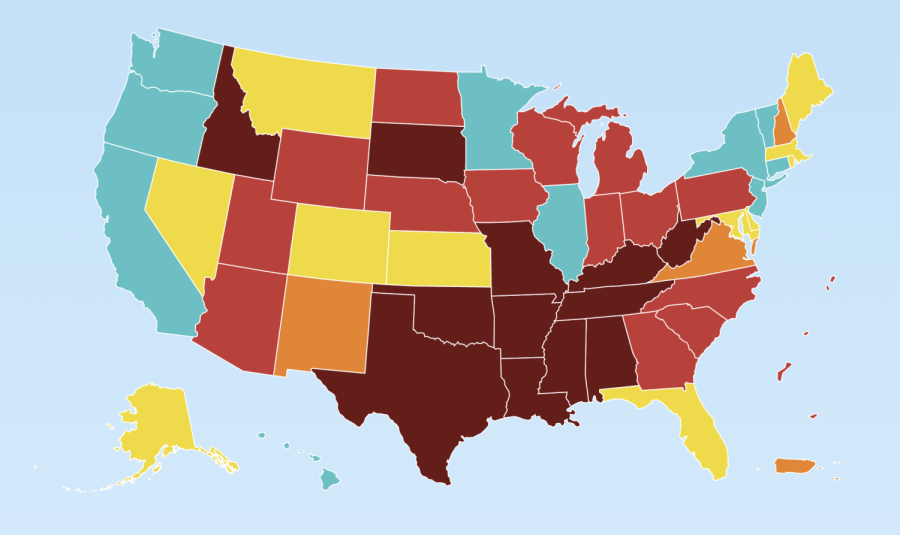After The Overturning: Examining the State of Abortions since the Supreme Court’s Ruling
Image provided by the Center for reproductive rights depicting the varying states’ abortion laws since the overturning of Roe. Blue – Abortion access expanded since the banning Yellow- Allowed but no changes made Orange- Not Protected Red- Hostile Dark red – Illegal *credit: Center for Reproductive Rights
November 23, 2022
*Note this article was written and researched before the 2022 Midterm Elections
On June 24th, 2022, five out of the nine US Supreme Court justices joined an opinion in Dobbs v Jackson Women’s Health Organization to overturn abortion rights in the US. In the four months following the overturning of Roe v. Wade, states across the country have responded in varying ways. Some have made abortion illegal whereas other states have expanded its access. The Supreme Court overturning Roe v. Wade does not in fact mean that abortion, in general, is illegal but instead declares that the decision is up to each state and it removes all federal constitutional protections. When Roe v. Wade was overturned, it was shocking yet expected due to the current climate of the court. In anticipation, states introduced and organized trigger bans. Trigger bans were intended to make abortion illegal as soon as Roe v. Wade was overturned. Currently, ten states have put trigger bans in effect. So, what should we expect?
Enormous consequences brought by the overturning of Roe v. Wade will disproportionately affect people with lower incomes. People with higher incomes will be less affected since they can travel out of state if needed to safely procure an abortion. Women from economically distressed households and teenagers with unsupportive parents would likely be most impacted by the overturning. Without the money to procure a safe abortion, they are left with the option of unsafe, unregulated, and illegal abortions. Women of color will also be largely impacted due to biases in medical practice and systemic inequalities. For example, Black women die during pregnancy and postpartum periods at a rate of 3-4 times more than white women. An overarching reason why this happens is due to implicit biases about Black women’s general health, and assumptions about health conditions, pain tolerance, and more. Black women are also discharged from the hospital postpartum earlier than white patients. Similarly, Native American women are dying at a rate of 2-3 times higher than white women. Only 66% of Native American women receive healthcare during the first trimester of pregnancy, as opposed to 81% of white women. This is largely due to institutional barriers, such as long waits for appointments with their doctors, transportation issues, and lack of sustained doctor-patient relationships. Like Black and Native American women, Latinx women also have a higher rate of severe maternal morbidity (SMM) when compared with white women.
Outside of the US, many people were shocked by the overturning. Human rights experts condemned the decision, as did government officials. Former Prime Minister of Italy Emma Bonino said that the Supreme Court’s decision could allude to the risk of Italy moving backward and “losing achievements that had seemed permanent.” Foreigners fear that the U.S. could just be the starting point, prompting additional countries to follow and set our society back 50 years. In Ireland, University lecturer Dr. Jennifer Cassidy said, “the world continues to watch America become unrecognizable.” The US’s decision in overturning Roe v. Wade is setting us further apart from other countries. If this continues we very well may be cutting off links with some of our closest allies, such as Canada, which has liberal access to abortion, as well as Denmark and the UK, which both have slightly more restrictions, but still allow abortions for medical reasons at all stages of the pregnancy.
Furthermore, each US state has had its own reaction to the overturning of Roe v. Wade. For example, a number of states have expanded abortion access since the overturning, including California, Washington, New York, and New Jersey. Other states have enacted or sought to enforce abortion bans. In a total of twelve states, abortion is completely banned from the moment of conception with very limited exceptions. This includes the trigger ban states. In a few other states, such as Georgia, Arizona, and Florida, abortion is banned at early points in pregnancy. According to an article from the University of California San Francisco Parnassus Campus, “one in three people learn they are pregnant past six weeks gestation.” Adding on, “one in five people find out [that they are pregnant] after seven weeks.” Most women won’t have known about their pregnancy until after the six-week period, making an abortion extremely hard to get. According to the Center for Reproductive Rights, 26 states are expected to completely ban abortion. Generally, the southern and mid-western states have more abortion restrictions, whereas the East and West Coast tend to have better access. Many believe that Roe v. Wade is just the Supreme Court’s first decision, and that they will soon come after same-sex marriage and interracial marriage.


















